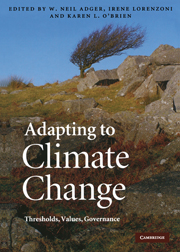29 results
9 - Place Attachment, Identity, and Adaptation
-
-
- Book:
- The Adaptive Challenge of Climate Change
- Published online:
- 05 August 2015
- Print publication:
- 07 August 2015, pp 160-170
-
- Chapter
- Export citation
23 - Barriers and Limits to Adaptation: Cautionary Notes
- from Part V - Synthesis Chapters
-
-
- Book:
- Natural Disasters and Adaptation to Climate Change
- Published online:
- 05 October 2013
- Print publication:
- 14 October 2013, pp 223-235
-
- Chapter
- Export citation
Contributors
-
-
- Book:
- Natural Disasters and Adaptation to Climate Change
- Published online:
- 05 October 2013
- Print publication:
- 14 October 2013, pp ix-xii
-
- Chapter
- Export citation
Chapter 7 - Managing the Risks: International Level and Integration across Scales
- from Section III
-
-
- Book:
- Managing the Risks of Extreme Events and Disasters to Advance Climate Change Adaptation
- Published online:
- 05 August 2012
- Print publication:
- 28 May 2012, pp 393-436
-
- Chapter
- Export citation
12 - Ethical dimensions of adapting to climate change-imposed risks
-
-
- Book:
- The Ethics of Global Climate Change
- Published online:
- 11 April 2011
- Print publication:
- 31 March 2011, pp 255-271
-
- Chapter
- Export citation
5 - Fair decision making in a new climate of risk
-
-
- Book:
- Climate Change, Ethics and Human Security
- Published online:
- 01 June 2011
- Print publication:
- 22 July 2010, pp 83-94
-
- Chapter
- Export citation
Preface
-
- Book:
- Adapting to Climate Change
- Published online:
- 31 August 2009
- Print publication:
- 25 June 2009, pp xiii-xvi
-
- Chapter
- Export citation
Frontmatter
-
- Book:
- Adapting to Climate Change
- Published online:
- 31 August 2009
- Print publication:
- 25 June 2009, pp i-iv
-
- Chapter
- Export citation

Adapting to Climate Change
- Thresholds, Values, Governance
-
- Published online:
- 31 August 2009
- Print publication:
- 25 June 2009
Contents
-
- Book:
- Adapting to Climate Change
- Published online:
- 31 August 2009
- Print publication:
- 25 June 2009, pp v-vii
-
- Chapter
- Export citation
28 - Accessing diversification, networks and traditional resource management as adaptations to climate extremes
-
-
- Book:
- Adapting to Climate Change
- Published online:
- 31 August 2009
- Print publication:
- 25 June 2009, pp 448-464
-
- Chapter
- Export citation
Index
-
- Book:
- Adapting to Climate Change
- Published online:
- 31 August 2009
- Print publication:
- 25 June 2009, pp 501-514
-
- Chapter
- Export citation
1 - Adaptation now
-
-
- Book:
- Adapting to Climate Change
- Published online:
- 31 August 2009
- Print publication:
- 25 June 2009, pp 1-22
-
- Chapter
- Export citation
List of contributors
-
- Book:
- Adapting to Climate Change
- Published online:
- 31 August 2009
- Print publication:
- 25 June 2009, pp viii-xii
-
- Chapter
- Export citation
Part I - Overview and Context
-
- Book:
- Governing Sustainability
- Published online:
- 05 June 2012
- Print publication:
- 05 February 2009, pp 1-2
-
- Chapter
- Export citation
Preface
-
-
- Book:
- Governing Sustainability
- Published online:
- 05 June 2012
- Print publication:
- 05 February 2009, pp xvii-xviii
-
- Chapter
- Export citation
Part II - Governance and Government
-
- Book:
- Governing Sustainability
- Published online:
- 05 June 2012
- Print publication:
- 05 February 2009, pp 53-54
-
- Chapter
- Export citation
Frontmatter
-
- Book:
- Governing Sustainability
- Published online:
- 05 June 2012
- Print publication:
- 05 February 2009, pp i-vi
-
- Chapter
- Export citation
Part IV - Governance and Decision Making
-
- Book:
- Governing Sustainability
- Published online:
- 05 June 2012
- Print publication:
- 05 February 2009, pp 191-192
-
- Chapter
- Export citation
1 - Sustainability: exploring the processes and outcomes of governance
-
-
- Book:
- Governing Sustainability
- Published online:
- 05 June 2012
- Print publication:
- 05 February 2009, pp 3-31
-
- Chapter
- Export citation



